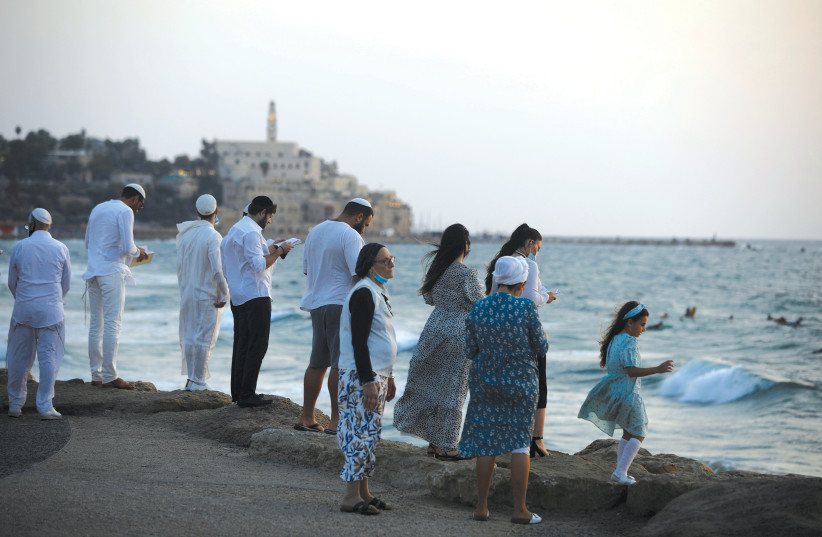Rosh Hashanah 5784 falls, as it does every year, at sundown on the evening of the 1st of Tishrei.
Tishrei is the first month of the Hebrew calendar, which follows the lunar cycle, explaining why Jewish holidays begin the night before. The Hebrew calendar emerged thousands of years ago in the Levant. Yet another symbol of Jewish continuity, this ancient form of timekeeping is also the official calendar for the modern Jewish state.
Rosh Hashanah has its origins in the connection to the land. It traditionally marks the beginning of the agrarian economic year, marking the start of the farming, growth, and harvesting seasons. Sukkot (the Feast of Ingathering), Passover (the Feast of Barley Harvest), and Shavuot (the Feast of Harvest), known as our shalosh regalim (three foot-festivals), are all rooted in the Land of Israel. The fact that Jews carry out these practices together with celebrating Rosh Hashanah, is a testament to our indigeneity in the Land of Israel.
Over a 24-hour period, accounting for time differences, Jews all over the world will come together as a community to begin the celebrations for Rosh Hashanah. When you think about it, this is a remarkable phenomenon.
As with much of our Jewish observances, many of us fail to realize its significance and profundity. If we go to synagogue, we will hear the shofar, an instrument fashioned from a ram’s horn. The sound of the shofar has been heard at Rosh Hashanah ever since the rabbis of the Talmud concluded that it must be used for teruah - horn blowing.

During the synagogue service and in our homes before meals, we pray in Hebrew, the indigenous language of the Jewish people. We will eat apple and honey, a round challah, and many of us will consume pomegranate to celebrate. The pomegranate is one of the shivat haminim (seven species, native to Israel). They are also understood to contain 613 seeds, symbolizing the number of commandments in the Torah.
I remember the pomegranate playing an important role in my own family’s celebration. No matter where we are in the world, we will more or less celebrate an ancient Jewish holiday on the same day and in the same manner. These customs, practiced over the centuries, are a shining beacon of Jewish indigeneity.
If we consider the last point in the United Nations’ criteria for indigeneity, “Resolve to maintain and reproduce their ancestral environments and systems as distinctive peoples and communities,” this is exactly what we do every Rosh Hashanah – just like so many other aspects of our lived experience as Jews. Wherever we are in the world, despite evolutions and permutations, we are reproducing our indigenous civilization.
Surviving and thriving
Numerous brilliant minds throughout history have pondered the miracle of Jewish survival. Blaise Pascal, the French mathematician, noted, “The Jews are not eminent solely by their antiquity, which is also singular due to their duration that has always continued from their origin until now,” while Winston Churchill stated, “Some people like Jews and some do not, but no thoughtful man can doubt the fact that they are beyond all question the most formidable and the most remarkable race which has ever appeared in the world.”
As we are so familiar with the retelling of our story, we forget how remarkable this aspect of our tradition really is.
Many Jews will celebrate (and non-Jews will ponder) our survival, but we have to recognize that in holding on to these customs, we have done so much more than that. We thrived. We evolved our culture, while maintaining direct links with our indigenous civilization. That is part of what Rosh Hashanah, this coming Friday, night represents. It reinforces and reminds us of the powerful and strong threads that connect us to our past, as well as our future.
We are an ancient civilization that persists in the modern world. This is no accident. Generations of Jews committed themselves to the greater project of Jewish survival. They understood that they were part of something bigger than themselves, something special. Many of them would not, even under the most painful circumstances, shirk their responsibilities for Jewish continuity. Much of this has been carried out through the preservation of our ancient customs and practices.
As we approach 5784 and a new Jewish year, looking at it from this perspective, I find it to be incredibly profound. We are both a modern and ancient people. We celebrate historic holidays in a modern setting, and we have a modern Jewish state built on our indigenous lands. Each of us, possibly without even realizing it, represents this duality. Through observing Jewish traditions, we affirm both our indigeneity, our survival, and our contemporaneity.
So, l’chayim! However you mark Rosh Hashanah, you are taking part in the continuity of the Jewish people – honoring and celebrating our indigeneity while simultaneously ensuring our very survival.
Shanah tovah u’metukah – a good and sweet year.
The writer is the founder of the modern Jewish Pride movement, an educator, and the author of Jewish Pride: Rebuilding a People. His new book, Reclaiming Our Story: The Pursuit of Jewish Pride, is now available.
